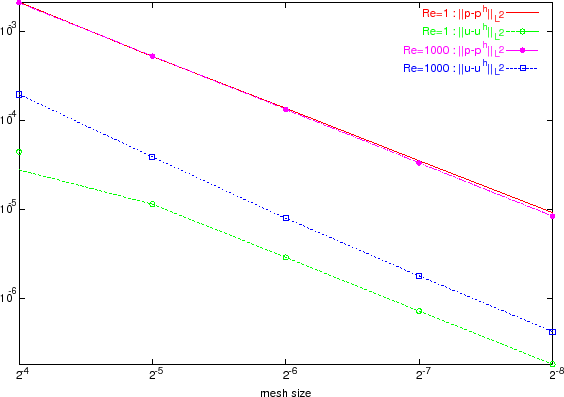Subsections
Collaborator: H. Langmach
Cooperation with: A. Linke (Freie Universität Berlin (DFG Research Center
MATHEON))
Supported by: DFG Research Center MATHEON, project C2
Description:
One important application
for solving the Navier-Stokes equation at WIAS has been the flow simulation
of crystal melts in Czochralski crystal growth. This research is continued
by the project C2 at the DFG Research Center MATHEON.
The simulation of crystal growth makes very high demands on available computing
time. Typically, the three-dimensional simulation of small model problems for
industrial crystal growth with our efficient Navier-Stokes solver
NAVIER needs computing time in the order of
weeks.
This has to be reduced by new software
techniques delivered by pdelib2
and new mathematical methods and algorithms.
On the mathematical side the
focus lies on robust discretization and robust iterative solvers for the
Navier-Stokes equations. As shown below, the standard Taylor-Hood (
Pk+1 - Pk)
discretization
for the Navier-Stokes equation does not fully accomplish these robustness
requirements. Therefore, we consider alternative discretization methods.
We started with the implementation and investigation of the
stabilized P1-P1 element. This element is used for preconditioning purposes.
Let us look at the
following simple model problem, a stationary generalized Stokes problem:
-   u + u +  p p |
= |
f , , |
|
 . u . u |
= |
0 , , |
(1) |
| u |
= |
0 |
|
Let
(uh, ph) denote the discrete solution of (1)
obtained by the
Taylor-Hood (
Pk+1 - Pk) mixed finite element method.
Then one can derive the following a priori FEM error estimate 1
h|u - uh|H1 + ||u - uh||L2  Ch2(|u|H2 + Re| p|H1), Ch2(|u|H2 + Re| p|H1),
|
(2) |
where C depends on  . In the case that
Re is high,
the second term in the error estimate possesses a large weighting factor.
This effect can be reproduced numerically
([1])
and is not limited to the Taylor-Hood element family. For the Navier-Stokes
equation, one can make a similiar observation.
. In the case that
Re is high,
the second term in the error estimate possesses a large weighting factor.
This effect can be reproduced numerically
([1])
and is not limited to the Taylor-Hood element family. For the Navier-Stokes
equation, one can make a similiar observation.
In 2004, the implementation of a stabilized P1-P1 element for
Stokes equations using pdelib2 has been completed.
This will be used for preconditioning by algebraic multigrid methods.
Stabilized P1-P1 elements have interesting robustness properties
in respect of high Reynolds number flow ([2]), but have a low
approximation order.
The robustness is shown by the following numerical study. The example is taken
from [1] and is typical for the kind of investigated problems. We look
for a numerical solution of [1] with
Re = 1
and
Re = 1000 in the unit square
 = [0, 1]2.
= [0, 1]2.  is the respective optimal stability parameter.
We prescribe the solution to
u = (u1, u2)
and p given by
is the respective optimal stability parameter.
We prescribe the solution to
u = (u1, u2)
and p given by
| u1(x, y) |
= |
2x2(1 - x)2(y(1 - y)2 - y2(1 - y)) |
|
| u2(x, y) |
= |
-2y2(1 - y)2(x(1 - x)2 - x2(1 - x)) |
|
| p(x, y) |
= |
x3 + y3 -  . . |
|
References:
- S. GANESAN, V. JOHN,
Pressure separation -- A technique for improving the velocity error
in finite element discretisations of the Navier-Stokes equations,
to appear in: Appl. Math. Comput.
- G. LUBE, M.A. OLSHANSKII,
Stable finite-element calculation of incompressible flows
using the rotation form of convection,
IMA J. Numer. Anal., 22 (2002), pp. 437-461.
LaTeX typesetting by H. Pletat
2005-07-29
